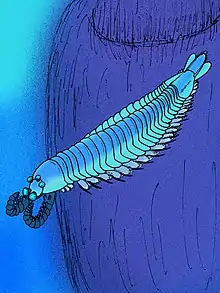Kylinxia
Kylinxia is a genus of extinct arthropod described in 2020. It was described from six specimens discovered in Yu'anshan Formation (Maotianshan Shales) in southern China. The specimens are assigned to one species Kylinxia zhangi.[1] Dated to 518 million years, the fossils falls under the Cambrian period.[2] Announcing the discovery on 4 November 2020 at a press conference, Zeng Han of the Nanjing Institute of Geology and Paleontology, said that the animal "bridges the evolutionary gap from Anomalocaris to true arthropods and forms a key ‘missing link’ in the origin of arthropods,"[3] which was "predicted by Darwin’s evolutionary theory."[4] The same day the formal description was published in Nature.[1]
| Kylinxia | |
|---|---|
 | |
| artist's restoration | |
| Scientific classification | |
| Kingdom: | |
| Phylum: | |
| Genus: | †Kylinxia |
| Species: | †K. zhangi |
| Binomial name | |
| Kylinxia zhangi Zeng et al., 2020 | |
Discovery
Kylinxia zhangi was discovered among the Maotianshan Shales from Yu'anshan Formation at Yunnan in southern China in 2019. Zeng Han, Zhao Fangchen, and Huang Diying of the Nanjing Institute of Geology and Palaeontology, Chinese Academy of Sciences, made the formal description and taxonomy in Nature in 2020. They found six specimens which are well preserved and complete. The original specimens (holotype) is kept at the Nanjing Institute of Geology and Palaeontology, while the additional specimens (paratypes) are maintained at the Yingliang Stone Natural History Museum.[1]
Etymology
The genus name Kylinxia refers to a mixture of arthropod characters; kylin (qilin) is derived from the chimeric creature in Chinese mythology, while xia (蝦) is a Chinese word for shrimp-like arthropod. The species name zhang is after Yehui Zhang who discovered the additional specimens (paratypes).[2]
Description
Kylinxia is a tiny shrimp-like arthropod, measuring about 5 cm long and about 1.2 cm broad at the widest part of the body.[1] It looks similar to the younger, and related Cambrian animal Opabinia, which is a purported basal arthropod.[5] Like Opabinia, Kylinxia has five eyes, and a long, segmented body. Its body is divisible into three regions, namely head, trunk and the pygidium.[6] The head is a fused shield and bears the five eyes that are attached through eye stalks. Two of the eyes are double the size of the other three. In contrast to Opabinia, which has a proboscis[7] possibly resulting from the fusion of a pair of frontal appendages,[8] the head region of Kylinxia has a pair of unfused, 15-jointed frontalmost appendages each of which has terminal and serrated inner spines (endites), similar to those seen in radiodonts[2] such as Anomalocaris and Ramskoeldia.[9] Unlike radiodonts, the frontalmost appendages face upward and lack outer spines, which is a feature of other Cambrian arthropods, the megacheirans.[10]
The trunk covers most of the body length and is composed of up to 25 segments (tergites). The trunk appendages are all two-branched (biramous) with the leg-like inner branches (endopod) each composed of about seven segments.[1] The pygidium bears three-lobed tail fan consisting of a middle and a pair of lateral flaps as seen in several Cambrian arthropods.[11]
References
- Zeng, Han; Zhao, Fangchen; Niu, Kecheng; Zhu, Maoyan; Huang, Diying (2020). "An early Cambrian euarthropod with radiodont-like raptorial appendages". Nature. 588 (7836): 101–105. doi:10.1038/s41586-020-2883-7. PMID 33149303. S2CID 226248177.
- Weisberger, Mindy (5 November 2020). "500 million-year-old creature with mashup of bizarre features could be arthropod 'missing link'". livescience.com. Retrieved 2020-11-06.
- "Five-eyed fossil shrimp could be 'missing link' in arthropod evolution". The Japan Times. 2020-11-05. Retrieved 2020-11-06.
- "Five eyes and quite a story to tell". Cosmos Magazine. 2020-11-04. Retrieved 2020-11-06.
- Bergström, J. (1986). "Opabinia and Anomalocaris, unique Cambrian arthropods". Lethaia. 19 (3): 241–246. doi:10.1111/j.1502-3931.1986.tb00738.x.
- de Lazaro, Enrico (6 November 2020). "Cambrian Shrimp-Like Arthropod Had Five Eyes". Sci-News.com. Retrieved 2020-12-03.
- Briggs, Derek E. G. (2015). "Extraordinary fossils reveal the nature of Cambrian life: a commentary on Whittington (1975) 'The enigmatic animal Opabinia regalis, Middle Cambrian, Burgess Shale, British Columbia'". Philosophical Transactions of the Royal Society of London. Series B, Biological Sciences. 370 (1666). doi:10.1098/rstb.2014.0313. PMC 4360120. PMID 25750235.
- Chipman, Ariel D. (2015-12-18). "An embryological perspective on the early arthropod fossil record". BMC Evolutionary Biology. 15 (1): 285. doi:10.1186/s12862-015-0566-z. ISSN 1471-2148. PMC 4683962. PMID 26678148.
- Cong, Pei-Yun; Edgecombe, Gregory D.; Daley, Allison C.; Guo, Jin; Pates, Stephen; Hou, Xian-Guang (2018). Zhang, Xi-Guang (ed.). "New radiodonts with gnathobase-like structures from the Cambrian Chengjiang biota and implications for the systematics of Radiodonta". Papers in Palaeontology. 4 (4): 605–621. doi:10.1002/spp2.1219.
- Chen, Junyuan; Waloszek, Dieter; Maas, Andreas (2004). "A new 'great-appendage' arthropod from the Lower Cambrian of China and homology of chelicerate chelicerae and raptorial antero-ventral appendages". Lethaia. 37 (1): 3–20. doi:10.1080/00241160410004764.
- Legg, David A.; Vannier, Jean (2013). "The affinities of the cosmopolitan arthropod Isoxys and its implications for the origin of arthropods". Lethaia. 46 (4): 540–550. doi:10.1111/let.12032.
